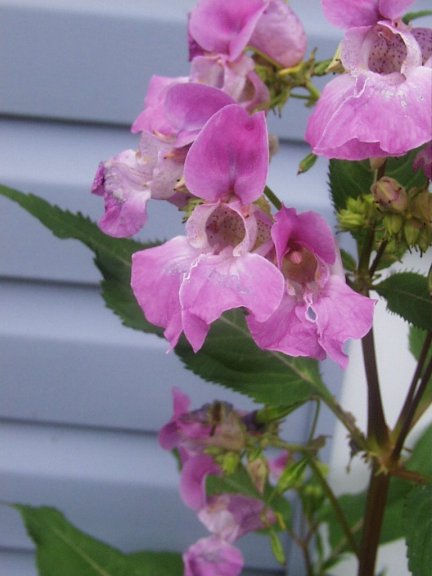

The specimen above was found
in Trenton.
Those below were found on the
Rotary Trail in Peterborough.
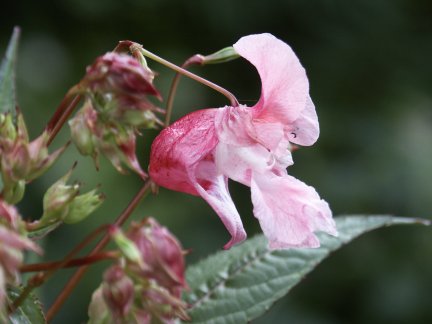
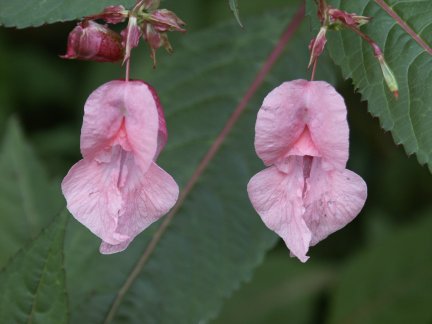

Patricia Oderkirk from Norton,
New Brunswick submitted the above photo of Indian Touch-Me-Not. Note its
height of about 7 feet. Impressive.
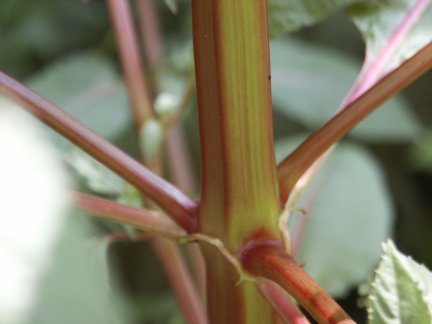
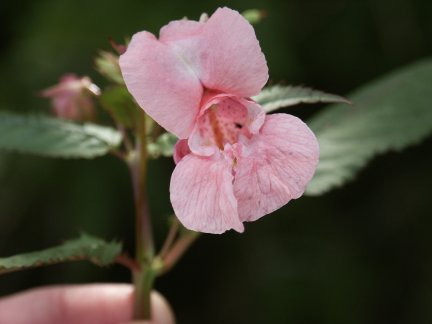
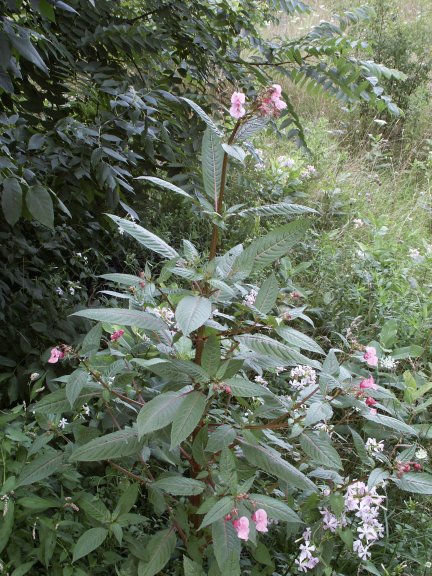
• Habitat: swamps, streamsides
• Height: 1-3 feet
• Flower size: 1 to 2 inches
long
• Flower color: pink to blue
to purple
• Flowering time: July to September
Description and Variation: Impatiens glandulifera, or policeman’s helmet, is an herbaceous annual that is succulent and glabrous (smooth and hairless), and it can range from three to ten feet tall. The upright, hollow stems are easily broken and they have a purplish tinge. The leaf arrangement can be opposite or whorled, with (usually) three leaves to a node. The simple leaves range from oblong to ovate to elliptic (egg shaped), and they are about six inches long and half as wide. The leaf margins are sharply serrate with 20 teeth, or more, along each side. Each leaf has a stout petiole (stem), with small, glandular stalks found at the base of these petioles. Several solitary flowers terminate an elongated axillary stalk. The flowers are irregular, with five petals (two fused), three sepals (two fused) and five stamens with connate (fused) filaments. The overall flower shape resembles an English policeman’s helmet. The fused sepals form a spur less than six mm long. The flower color ranges from white to all shades of pink and purple. The fruit is a five chambered capsule. When touched, the mature capsule explodes and ejects up to 800 seeds. The roots extend four to six inches deep, with adventitious roots found along the lower stem nodes, sometimes buttressing.
Economic Importance: Detrimental: Policeman's helmet is one of the "top 20" aliens in Great Britian because of abundance and distribution. It is considered extremely invasive to moist, natural areas. It is the tallest annual herb of British flora (Beerling and Perrins 1993). Beneficial: Policeman's helmet is sold as a garden ornamental and is a late season source of nectar and pollen.
Habitat: Impatiens glandulifera tolerates a wide variety of soil types, but requires high soil moisture. Frost sensitivity may be a limiting factor in its distribution outside of its native land. In Himalaya, this species is frost tolerant, and it found at elevations up to 4,000 meters. (Beerling and Perrins 1993). Policeman's helmet is partially shade tolerant, and is found in lowland, riparian areas which include moist forests, stream sides, and roadside thickets. Associated species in western Washington sites include: blackberries (Rubus spp), Japanese knotweed (Polygonum cuspidatum), elderberry (Sambucus racemosa), Spirea douglassi ssp douglassi, reed canarygrass (Phalaris arundinacea), willows (Salix spp.), and ivy (Hedera helix).
Geographic Distribution: Native to India and the western Himalaya. I. glandulifera is considered naturalized throughout the United Kingdom, most of mainland Britain, Ireland, and several of the British Isles. It is found in 18 European countries between latitudes of 30 and 64 N; French Pyrenees, Holland, Germany, the Austrian Alps, Poland, Hungary, Yugoslavia, and parts of Russia. (Beerling and Perrins 1993). I. glandulifera is established in areas of western Washington and in the lower Fraser Valley of British Columbia (Pojar and MacKinnon 1994).
History: Seeds were sent from western Himalaya to Kew in 1839. Naturalized populations were reported in 1855, and continued to spread throughout moist, natural areas. By the 1900’s I. glandulifera was widespread in Ireland and England. By 1970 establishments were common in Scotland and the British Isles were rapidly colonized. It is considered extremely invasive, one of the "top 20" British aliens, because of abundance and distribution. It is the tallest annual herb of British flora (Beerling and Perrins 1993). The name impatiens means ‘impatient’ - referring to the explosive seed dispersal (Pojar and MacKinnon 1994).
Growth and Development: An annual, I. glandulifera germinates in February to March. Roots develop 12 days after germination and photosynthesis begins in the leaves four weeks after germination. Flowers are present from June to October, with shaded environments producing later flowers. This annual species can reach ten feet tall, in shaded areas. Seed set occurs about 13 weeks after flowering. When the seed capsules are mature, they split along the five seams of the fused stamens, ejecting seeds for up to 20 feet. The seeds travel along waterways, and they can germinate under water. The seeds are viable for 18 months, or more. I. glandulifera is susceptible to frost, both in the early seedling stage and at the mature plant stage. Pollinators include several species of bees, ten moth species, and wasps (Mumford 1988; Beerling and Perrins 1993).
Reproduction: Policeman's Helmet reproduces by seed (up to 800 seeds per plant). I. glandulifera is self compatible. The seeds are ejected over 20 feet from the capsule. The seeds do require cold stratification to break dormancy (Mumford 1988).
Response to Herbicides Policeman's helmet does respond to herbicides, with early season control recommended to prevent flowering, and late season application to control late-season non-flowering plants. Flowering plants sprayed with herbicide still produce viable seed (Beerling and Perrins 1993). More information is needed on local herbicide control options.
Response to Cultural Methods: Sheep and cattle graze the whole plant in Britain.
Response to Mechanical Methods: An annual with a shallow root system, Policeman's Helmet can be easily pulled. A seed bank is present with two year viability so follow up control is recommended.
Biocontrol Potentials: None known.
Source: http://www.nwcb.wa.gov/weed_info/policehelmit.html
Go
To Flower List
Go
To Flowers By Colour
Go
To White Flowers
Go
To Blue Flowers
Go
To Yellow Flowers
Go
To Red or Pink Flowers
Go
To Green Flowers
Go
To Orange Flowers
Go To
Index Page